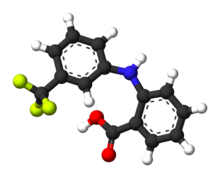Flufenamic acid
 |
|
 |
|
| Clinical data | |
|---|---|
| AHFS/Drugs.com | International Drug Names |
| Routes of administration |
oral, topical |
| ATC code | |
| Legal status | |
| Legal status |
|
| Pharmacokinetic data | |
| Protein binding | extensively |
| Metabolism | Hydroxylation, glucuronidation |
| Biological half-life | ~3 h |
| Excretion | 50% urine, 36% feces |
| Identifiers | |
|
|
| CAS Number | |
| PubChem CID | |
| IUPHAR/BPS | |
| DrugBank | |
| ChemSpider | |
| UNII | |
| KEGG | |
| ChEBI | |
| ChEMBL | |
| ECHA InfoCard | 100.007.723 |
| Chemical and physical data | |
| Formula | C14H10F3NO2 |
| Molar mass | 281.22991 g/mol |
| 3D model (Jmol) | |
| Melting point | 124 to 125 °C (255 to 257 °F) resolidification and remelting at 134°C to 136°C |
| Solubility in water | Practically insoluble in water; soluble in ethanol, chloroform and diethyl ether mg/mL (20 °C) |
|
|
|
|
Flufenamic acid is a member of the anthranilic acid derivatives (or fenamate) class of NSAID drugs Like other members of the class, it is a COX inhibitor and prevents formation of prostaglandins. Flufenamic acid is known to bind to and reduce the activity of prostaglandin F synthase and activate TRPC6.
It is not widely used in humans as it has a high rate (30-60%) of gastrointestinal side effects. It is generally not available in the US. It is available in some Asian and European countries as a generic.
Scientists led by Claude Winder from Parke-Davis invented flufenamic acid in 1963, along with fellow members of the class, mefenamic acid in 1961 and meclofenamate sodium in 1964.
...
Wikipedia
